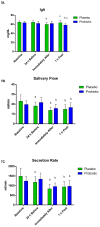Effect of Multi-Strain Probiotic Supplementation on URTI Symptoms and Cytokine Production by Monocytes after a Marathon Race: A Randomized, Double-Blind, Placebo Study
- PMID: 33925633
- PMCID: PMC8146695
- DOI: 10.3390/nu13051478
Effect of Multi-Strain Probiotic Supplementation on URTI Symptoms and Cytokine Production by Monocytes after a Marathon Race: A Randomized, Double-Blind, Placebo Study
Abstract
(1) Purpose: Performing strenuous exercises negatively impacts the immune and gastrointestinal systems. These alterations cause transient immunodepression, increasing the risk of minor infections, especially in the upper respiratory tract. Recent studies have shown that supplementation of probiotics confers benefits to athletes. Therefore, the objective of the current study was to verify the effects of probiotic supplementation on cytokine production by monocytes and infections in the upper respiratory tract after an acute strenuous exercise. (2) Methods: Fourteen healthy male marathon runners received either 5 billion colony forming units (CFU) of a multi-strain probiotic, consisting of 1 billion CFU of each of Lactobacillus acidophilus LB-G80, Lactobacillus paracasei LPc-G110, Lactococcus subp. lactis LLL-G25, Bifidobacterium animalis subp. lactis BL-G101, and Bifidobacterium bifidum BB-G90, or a placebo for 30 days before a marathon. Plasma cytokines, salivary parameters, glucose, and glutamine were measured at baseline, 24 h before, immediately after, and 1 h after the race. Subjects self-reported upper respiratory tract infection (URTI) using the Wisconsin Upper Respiratory Symptom Survey (WURSS-21). The statistical analyses comprised the general linear model (GLM) test followed by the Tukey post hoc and Student's t-test with p < 0.05. (3) Results: URTI symptoms were significantly lower in the probiotic group compared to placebo. The IL-2 and IL-4 plasma cytokines were lower 24 h before exercise, while the other cytokines showed no significant differences. A lower level of IL-6 produced by monocytes was verified immediately after the race and higher IL-10 at 1 h post. No differences were observed in salivary parameters. Conclusion: Despite the low number of marathoners participating in the study, probiotic supplementation suggests its capability to preserve the functionality of monocytes and mitigate the incidence of URTI.
Keywords: URTI; immunology; marathon race; monocytes; nutrition; probiotics; strenuous exercise.
Conflict of interest statement
The authors declare that they have no competing interests.
Figures







Similar articles
-
Thirty days of double-strain probiotic supplementation increases monocyte phagocytosis in marathon runners.Br J Nutr. 2024 Aug 14;132(3):298-308. doi: 10.1017/S0007114524001259. Epub 2024 Jun 3. Br J Nutr. 2024. PMID: 38826085 Clinical Trial.
-
Probiotic Supplements Beneficially Affect Tryptophan-Kynurenine Metabolism and Reduce the Incidence of Upper Respiratory Tract Infections in Trained Athletes: A Randomized, Double-Blinded, Placebo-Controlled Trial.Nutrients. 2016 Nov 23;8(11):752. doi: 10.3390/nu8110752. Nutrients. 2016. PMID: 27886064 Free PMC article. Clinical Trial.
-
Probiotic supplementation in marathonists and its impact on lymphocyte population and function after a marathon: a randomized placebo-controlled double-blind study.Sci Rep. 2020 Nov 2;10(1):18777. doi: 10.1038/s41598-020-75464-0. Sci Rep. 2020. PMID: 33139757 Free PMC article. Clinical Trial.
-
Higher risk of upper respiratory tract infection post marathon running: when physical exercise becomes a threat to the immune system.Exerc Immunol Rev. 2024;30:6-13. Exerc Immunol Rev. 2024. PMID: 39094181
-
Probiotic Supplementation and Respiratory Infection and Immune Function in Athletes: Systematic Review and Meta-Analysis of Randomized Controlled Trials.J Athl Train. 2021 Nov 1;56(11):1213-1223. doi: 10.4085/592-20. J Athl Train. 2021. PMID: 33481001 Free PMC article.
Cited by
-
The Athlete Gut Microbiome and its Relevance to Health and Performance: A Review.Sports Med. 2022 Dec;52(Suppl 1):119-128. doi: 10.1007/s40279-022-01785-x. Epub 2022 Nov 18. Sports Med. 2022. PMID: 36396898 Free PMC article. Review.
-
Dietary Strategies to Improve Exercise Performance by Modulating the Gut Microbiota.Foods. 2024 May 27;13(11):1680. doi: 10.3390/foods13111680. Foods. 2024. PMID: 38890909 Free PMC article. Review.
-
Effects of Probiotics Supplementation on Risk and Severity of Infections in Athletes: A Systematic Review.Int J Environ Res Public Health. 2022 Sep 13;19(18):11534. doi: 10.3390/ijerph191811534. Int J Environ Res Public Health. 2022. PMID: 36141804 Free PMC article.
-
Comparison of the Effects of Prebiotics and Synbiotics Supplementation on the Immune Function of Male University Football Players.Nutrients. 2023 Feb 25;15(5):1158. doi: 10.3390/nu15051158. Nutrients. 2023. PMID: 36904156 Free PMC article. Clinical Trial.
-
The Effect of Probiotic Supplementation on Cytokine Modulation in Athletes After a Bout of Exercise: A Systematic Review and Meta-Analysis.Sports Med Open. 2025 May 22;11(1):58. doi: 10.1186/s40798-025-00860-7. Sports Med Open. 2025. PMID: 40402402 Free PMC article.
References
Publication types
MeSH terms
Substances
Grants and funding
LinkOut - more resources
Full Text Sources
Other Literature Sources

